Flags of the Philippine Revolution
During the Philippine Revolution, various flags were used by the Katipunan secret society and its various factions, and later, after the Katipunan had been dissolved, the Philippine Army and its civil government.
Other flags were the personal battle standards of different military zone commanders operating around Manila.
Flags of the Revolution by the 1998 Philippine Centennial
A set of flags used by the Katipunan along with the Philippine national flag was flown at government institutions and building in occasion of the Philippine Centennial celebration in 1998. These set are often erroneously said to portray the "Evolution of the Philippine Flag". The Manila Historical Institute and the National Historical Institute has refuted the error saying that the flags excluding the current national flag are more rightfully referred as "Flags of the Revolution". While many of the depicted symbols and layouts on some of the flags have inspired the national flag, there is no direct relationship.[1]
Katipunan flags
 |
 |
 |
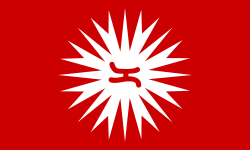 |
 |
| With the establishment of the Katipunan, Andrés Bonifacio requested his wife, Gregoria de Jesús, to create a flag for the society. De Jesús devised a simple red flag bearing the society's acronym, KKK, white and arranged horizontally at the center. This became the society's first flag.
Some Katipunan members used other variations. One variation has the three Ks arranged in the form of a triangle. Some others used a red flag with only one K. |
When the revolution heated up, the Magdiwang faction of the Katipunan, which operated in Cavite under Mariano Álvarez, adopted a flag consisting of a red banner with a white sun with the baybayin (the ancient Tagalog script) letter ka (for K) at the center. Bonifacio stated the "K" or "ka" in the middle of the Sun stood for Kalayaan (Freedom) not just Katipunan.[3]:105 | The Magdalo faction of the Katipunan, which also operated in Cavite under Emilio Aguinaldo, used a flag similar to the Magdiwang faction's, featuring a white sun with a baybayin letter ka. The sun initially had an indefinite number of rays and was later standardized to eight rays, to represent the eight provinces that Spanish colonial authorities placed under martial law (Manila, Cavite, Laguna, Batangas, Bulacan, Pampanga, Tarlac, and Nueva Ecija). An eight-rayed sun was later used in the national flag of the Philippines. | ||
Personal flags
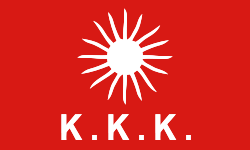 |
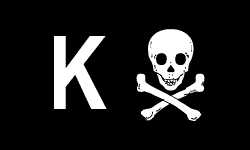 |
 |
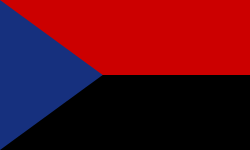 |
| Andres Bonifacio | General Mariano Llanera | General Pio del Pilar | General Gregorio Del Pilar |
| White sun with an indefinite number of rays on a field of red. Below the sun are three white Ks arranged horizontally. This flag was first unveiled on August 23, 1896 during the Cry of Pugadlawin where the assembled Katipunan members tore their cedulas (community tax certificates) in defiance of Spanish authority. The flag was used later during the Battle of San Juan del Monte on August 30, 1896, the first major battle of the Philippine Revolution. | Black flag with a white K on the left and a white skull and crossed bones on the right, resembling the Jolly Roger. Bonifacio referred to the flag as Bungo ni Llanera or Llanera's Skull | Red banner which has a white triangle on the hoist with a K at each angle. At the centre of the triangle was a mountain with a rising sun behind it.
The flag was called Bandila ng Matagumpay (Flag Of the Triumphants) and was first used on July 11, 1895. The flag was also one of the first to depict an eight-rayed sun. |
Tricolour with a blue triangle at the hoist, a red stripe at the top and a black stripe at the bottom. Del Pilar patterned his flag after that of Cuba's, which was also in revolt against Spain. |
First official Filipino flag
| Flag | Description | Year/Period |
|---|---|---|
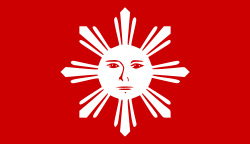 |
At the Naic Assembly on 17 March 1897, the Katipunan military leaders decided to adopt a new flag. The new design was red and depicted a white sun with eight rays and a face. This flag became the first official Philippine flag, but was used for less than a year because Filipino leaders signed a truce with Spanish authorities on 14 and 15 December 1897. | 1897-1898 |
Other flags
These are other flags which are not recognized during the Philippine Centennial celebration in 1998 but nevertheless still used during the Philippine Revolution
| Flag | Description | Usage |
|---|---|---|
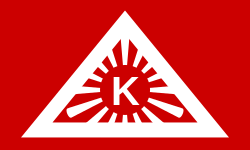 |
Flag adopted by Katipuneros of the Bicol region. The flag was used in many battles including the Battle of Agdangan.[4] Red banner consisting white triangle with rays of sun extending from the letter "K" | Katipuneros of Bicol region |
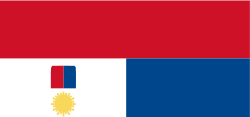 |
Aniceto Lacson, Juan Araneta and other Negrense revolutionists also used a tricolour flag in 1898. Their standard was inverted, with the red field in the upper part to indicate wartime and solidarity with other revolutionaries. and a sun that resembling a medal. | Negros Revolution |
 |
Flag used by Macario Sakay for the Tagalog Republic, Red banner with a white sun consisting of 16 rays with Baybayin syllable "ka" at the center | Tagalog Republic |
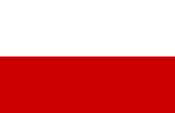 |
A horizontal bicolour of white and red | 1872 Cavite mutiny, prior to the Revolution |
Other Users
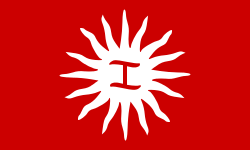
A modified version made to look like a Katipunan flag was used by an infamous group of mutineers who were members of the Armed Forces of the Philippines. This group stylized themselves as the Bagong Katipuneros ("new Katipuneros")[5] but labelled the "Magdalo Group" by media. They instigated several failed coup attempts in 2003 Oakwood mutiny and 2007 Manila Peninsula mutiny against the government of the Republic of the Philippines led by then President Gloria Macapagal-Arroyo. This group mutinied at the behest of Senator Gregorio Honasan and were at both times led by former navy officer Antonio Trillanes IV. Ironically, although called "Magdalo", the flag they used is actually closer to that of the Magdiwang faction of the Katipunan.
References
- 1 2 "The History of the Philippine Flag" (PDF). Merit Badge Center, Philippines. Retrieved 12 June 2016.
- ↑ "PHILIPPINE FLAG PICTURES EVOLUTION of the FILIPINO FLAG". PHILIPPINE-HISTORY.ORG. Retrieved 12 June 2016.
- ↑ Alvarez, S.V., 1992, Recalling the Revolution, Madison: Center for Southeast Asia Studies, University of Wisconsin-Madison, ISBN 1-881261-05-0
- ↑ http://www.watawat.net/flags_and_symbols_of_the_katipunan_-_3.html
- ↑ Laurel, Herman T (22 February 2006). "Small setback..." The Daily Tribune. Archived from the original on 2007-09-28. Retrieved 2007-08-10.
External links
- "The Evolution of the Philippine Flag." MSC's Philippine Centennial Celebration Website.
- "History of the Philippine Flag." National Commission for Culture and the Arts.
- "Philippines – Historical Flags." Flags of the World.
- "The History of the Philippine Flag." Merit Badge Center, Philippines.
